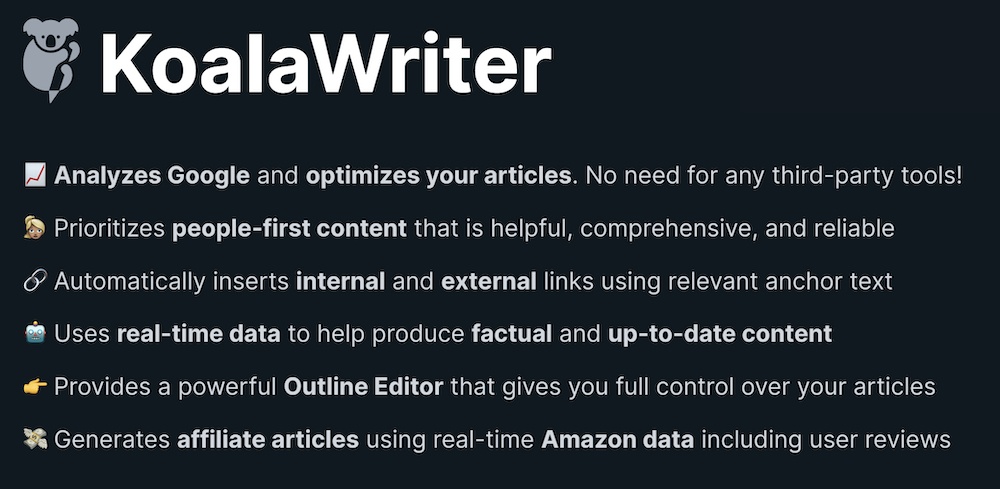Affiliate marketing content can be difficult to write, especially if you’re a beginner – but, if you’re willing to follow some simple instructions + you can commit to writing every day (practicing), I’m pretty sure you will get better at it was faster than you think.
In this article, I am going to teach you how to write content for affiliate marketing websites by providing you 8 simple tips and techniques to help you write content that brings in commissions all day, every day.
If that’s what you’re here to learn, here’s everything you will be learning about below.

Table of Contents
1. Know Your Objective
You must decide before you start writing what you are hoping to achieve.
You must think strategically and be specific. Once you’ve decided on the topic you want to write about, it may help to turn your keyword phrase into a question.
For example, if your keyword phrase is ‘affiliate marketing’, you will find writing about it easier by turning it into a question such as “What is affiliate marketing?” or “Why should you get into affiliate marketing?”
Michael Shore of EssayWritingLand, says:
‘’Don’t write your final headline until you have actually written the article but use the question to focus your thinking on what you want to convey in your content.’’ He adds, “I have found that content marketing costs less than traditional marketing and generates more leads.”
2. Know Your Audience
You need to figure out exactly who you’re writing for and keep them in mind at all times.
You must understand the needs and wants of your audience because they come to your content with a specific purpose in mind.
They don’t want to waste their time, and therefore they’re looking for content that’s concise, scannable, well-structured and authentic.
What do you want readers to feel when they read your content?
You don’t want them to feel that you are pushing products. People have been bombarded with, and they are tired of the market speak. You need to show them that you care about them and know what it’s like to be in their shoes.
If your readers have come to know and trust you, they won’t feel as though you’re trying to make money off them but that you’re recommending certain products because you’ve tried them yourself and know how much benefit they can receive from them.
3. Tell Your Story
Affiliate marketing should not feel like hard selling.
It should feel more like a recommendation from one friend to another. With this in mind, it’s useful to incorporate anecdotes about a service or a product into your content. It will keep your content fresh and build up trust with your readers.
If you tell stories and use testimonials, you will appeal to the reader’s emotions and senses.
Instead of just giving all the features of a product, you are communicating the benefits of using a product and what’s in it for your audience. One of the best ways to do this is to show how products and services have changed your life for the better.
4. Strive For Content Excellence
As an affiliate marketer, you want to earn from your website, but to do that, you have to go through a process.
You have to attract and build up trust with an audience before they’re willing to take advice from you and consider purchasing the services or products you are trying to sell.
The best way to do this is to provide consistent, high-quality content. If you are honest and authentic, people are likely to be drawn to your content.
If you become the go-to site for a specific topic, you will attract a huge audience. Only when you have attracted a large enough audience, can you really begin to monetize successfully.
5. Write Different Types of Content
Interesting and meaningful content attracts eyeballs in a world where people are tired of direct advertising. In most cases, they are so accustomed to it that they become blind to it.
Seasonal and evergreen blog posts, roundup posts and email mini-courses are just some forms of content on websites that are likely to be more successful than direct advertising
‘How to …’ posts are very popular and can include links to tools and materials used etc.
People are always searching for great reviews that are honest and well balanced. In writing reviews, you need to focus on the pros and cons of the product, so readers have more realistic expectations.
Nearly 90% of consumers report that they trust online reviews as much as personal recommendations.
You should tailor your reviews carefully to your target audience. Comparison reviews, where you measure one item against others are successful if they are well done.
Search engines and people love lists of all descriptions. Lists are also very shareable on social media. Creating a list of experts in your field is one idea.
You could write about top affiliate marketers, for instance, and then notify those who were included in your list. They might share the list with their followers and increase your reach.
As you craft affiliate content for your readers, it’s worth thinking about how you can get testimonials from others to support your recommendations.
6. Structure Your Content Carefully
Your introductory paragraph should set readers up for what they will get in the rest of the content. If you write your introduction as a teaser, it will intrigue them enough to continue reading instead of going off to find the next article.
Viewers tend to skim, and they will often scan headlines first. Therefore, you need to think about your headings carefully.
If readers don’t think they will find what they’re looking for by skimming the headlines, they won’t stick around to read the text. Good headlines can hook readers and make them want to know more.
Use hyperlinks, so readers are not bogged down by too much content.
They can simply click the link if they want more information. Links must be set to open in a new tab or window, so readers can easily go back to your website.
Use images that add value to the content and original ones are best. An image can be used in-between content to make it easier to read and more digestible.
Passive sentences tend to bore readers. Make sure you use active voice and avoid long rambling sentences or dense blocks of text. Any flowery language or complex sentences will put readers off.
Don’t use jargon, ambiguity, or language that’s too technical. Don’t write too formally and rather use short words, short sentences, and short paragraphs.
Your closing paragraph is just as crucial as your introduction. It should summarize what has appeared in the article and remind readers of its purpose.
Make it easy for readers to take action by telling them exactly what they should do next: order, buy, subscribe, join, visit, or donate.
You need to appeal to their emotions, communicate honestly, and conversationally with them and use your own experiences to reinforce what you are saying.
Of course, you can also offer them something tangible for taking action, such as a free download or a discount.
7. Write For People & For Search Engines
You need quality content to get into the good graces of your target market and the search engines. People used to stuff their weak content full of keywords to make it rank higher on search engines.
However, tactics have changed a great deal since those days. The search engines no longer rank weak articles full of keywords highly, and search has become far more semantic.
You must focus on writing excellent content, but you also must pay attention to SEO if you want readers to find your content on the search engines.
Choosing low competition keywords with decent traffic can make your content rank higher on Google search and attract more viewers.
You will find that the more your content matures, the more traffic it attracts, and the higher it starts to rank. Many of the Black Hat methods used in the past for getting rank are no longer effective, and top-quality content is more valuable than ever.
8. Share on Social Media
As you create new content in all its forms, you need to share it on social media networks, so it can be accessed by more people. Social sites like Twitter, Facebook, Pinterest, and Instagram are powerful tools for marketers and influencers.
As you craft posts, think about sharing affiliate links for products you’d like your audience to check out.
For example, if you write a post about the tools and resources to grow your blog, you could provide affiliate links to the products you use.
By using industry-specific, popular hashtags on your Tweets and posts, you can expand your reach to those looking for content on that hashtag. Hashtags must be relevant, or they will come across as spammy.
As you start learning what works and what doesn’t work, you can start tailoring your content to your specific audience. The more you can do this, the more commission you’re likely to earn.
Learn Affiliate Marketing From The Pros

If you’re brand new to affiliate marketing, one more tip I can share with you (that doesn’t involve writing content) is to know and understand what you’re doing.
Articles such as this one tell you the why and the what but the HOW is often left out as it’s the hardest to communicate.
What works best for learning how to do certain things is video, and I have a free affiliate marketing video course right here for you.
